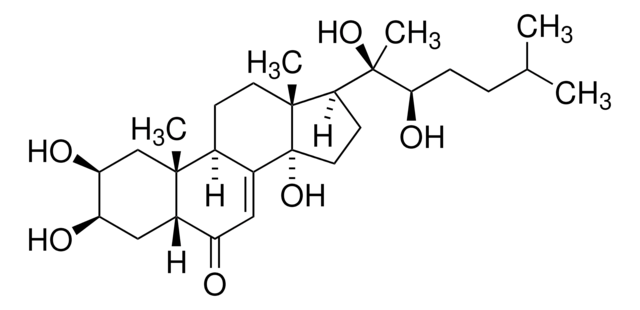E9004
α-Ecdysone
≥90%
Synonym(s):
2β,3β,14α,22(R),25-Pentahydroxy-7-cholesten-6-one
About This Item
Recommended Products
sterility
non-sterile
Quality Level
Assay
≥90%
form
powder
solubility
methanol: 20 mg/mL, clear, colorless to faintly yellow
application(s)
agriculture
environmental
shipped in
ambient
storage temp.
−20°C
SMILES string
[H][C@]12CC[C@]3(C)[C@H](CC[C@@]3(O)C1=CC(=O)[C@]4([H])C[C@@H](O)[C@@H](O)C[C@]24C)[C@H](C)[C@H](O)CCC(C)(C)O
InChI
1S/C27H44O6/c1-15(20(28)8-9-24(2,3)32)16-7-11-27(33)18-12-21(29)19-13-22(30)23(31)14-25(19,4)17(18)6-10-26(16,27)5/h12,15-17,19-20,22-23,28,30-33H,6-11,13-14H2,1-5H3/t15-,16+,17-,19-,20+,22+,23-,25+,26+,27+/m0/s1
InChI key
UPEZCKBFRMILAV-JMZLNJERSA-N
Looking for similar products? Visit Product Comparison Guide
General description
Application
- to study its effects on Drosophila melanogaster′s sexual maturation
- to study its effects on specification of neurons in Drosphila male-specific neurite
- as a standard to evaluate the ecdysteroid levels by liquid chromatography-mass spectrometry (LC-MS/MS)
Biochem/physiol Actions
Storage Class Code
11 - Combustible Solids
WGK
WGK 3
Flash Point(F)
Not applicable
Flash Point(C)
Not applicable
Personal Protective Equipment
Certificates of Analysis (COA)
Search for Certificates of Analysis (COA) by entering the products Lot/Batch Number. Lot and Batch Numbers can be found on a product’s label following the words ‘Lot’ or ‘Batch’.
Already Own This Product?
Find documentation for the products that you have recently purchased in the Document Library.
Our team of scientists has experience in all areas of research including Life Science, Material Science, Chemical Synthesis, Chromatography, Analytical and many others.
Contact Technical Service






